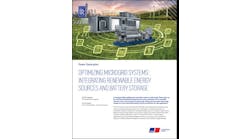Data Center Load Commitment: Big Tech Signs on to AEP Indiana Agreement for Grid Upgrade Financing
The utility sector’s challenge to meet future data center demand may require new capacity including microgrids and/or distribution system upgrades. Whatever the means of supplying enough power for new AI-focused data centers, the grid side will require vast amounts of investment.
To handle that end, American Electric Power (AEP)-owned utility Indiana Michigan Power has filed a joint settlement on future data center load commitments with some of the nation’s biggest tech companies.
Indiana Michigan Power (I&M) joined with the Indiana Office of Utility Consumer Counselor, ratepayer advocate Citizens Action Coalition and Data Center Coalition on the settlement that requires new large load customers to make long-term financial commitments so that will ensure the costs of serving their customers are “reasonably recovered” from the customer.
Big Three Band Together with Utility, Regulators
Among the tech giants signing on to the Indiana agreement include Google, Amazon Web Services and Microsoft. Recently, parent company AEP revealed during an earnings update that it has close to 15 GW in future load commitment from data center customers.
Delivering 15 GW of new power generation capacity to meet both industrial and data center load growth will cost billions of dollars in infrastructure construction and new resource investment.
“The settlement filed with the Indiana Utility Regulatory Commission (IURC) recognizes the energy needs of new large customers and proposes additional commitments that these customers must meet when establishing electric service,” reads the release announcing the collaborative agreement with the tech companies. “These new requirements are important to balance the interest of the new customers with the interest of I&M’s existing customers.”
The current and anticipated future growth in data center construction is spurred by a rise in artificial intelligence training models and cloud-based computing needs.
Big Money, Big Interconnection Headaches
Earlier this year, Amazon Web Services (AWS) announced it was investing $11 billion in a new data center campus close to New Carlisle, Indiana. Meanwhile, Google also revealed plans for a $2 billion data center in Fort Wayne.
“AWS is excited to be expanding our operations in Indiana and be part of the state’s growing tech sector. We have recently announced an $11 billion investment that will create numerous well-paying jobs and significantly contribute to the state’s economy,” said Brandon Oyer, Head of Energy & Water for the Americas, AWS, in a statement. “Through continued partnership with I&M, this agreement supports the ongoing investment to modernize the local electric grid for the benefit of all ratepayers and ensure that costs to support data center growth are not passed along to other customers.”
All told, the coming data center investment in Indiana and AEP’s other territories could pour billions into local economies and create rising demand for utilities, but the infrastructure costs of adding capacity, transmission and distribution energy assets also costs billions and requires capital expenditures that can elevate costs for regular customers, including residential ratepayers in the low-income brackets.
“As ratepayer advocates since 1974, Citizens Action Coalition takes very seriously our role as watchdogs for utility consumers,” said Kerwin Olson, CAC Executive Director. “This settlement includes significant protections for I&M ratepayers as these large new loads come online in Indiana and provides for increased transparency into the energy needs and impacts of these new customers. Additionally, the contribution to INCAA will enable meaningful assistance and support for low-income Hoosiers in managing their monthly energy bills, including weatherization services to make homes more efficient, healthier, and safer.”
To further demonstrate the commitment of supporting the local communities, the companies that are signatories to this joint settlement—AWS, Microsoft, and Google—have each agreed to provide an annual contribution of $500,000 for five years to the Indiana Community Action Association, which provides various programs to support low-income Hoosiers once those companies begin taking service in the I&M service territory.
The Data Center Energy Trilemma
A few months ago, in data center-heavy northern Virginia, a group of industry experts met in a panel at the inaugural Data Center Frontier Trends Summit to discuss the so-called “Data Center Energy Trilemma." This triangle of challenges includes energy, cost of investment and meeting demand while still trying to meet sustainability and decarbonization goals.
Time is also a factor. The interconnection queue for new power projects, particularly distributed energy resources, is sometimes several years long. The data center industry capacity and load profile is changing so fast—and growing ever more crucial to national security—that these delays are not acceptable and create the tri-lemma mentioned earlier.
“We can’t build fast enough,” Chris McLean, principal at Critical Facilities Group, pointed out during the Data Center Frontier Trends Summit. “There’s not enough electricity on earth to satisfy the demand.”








